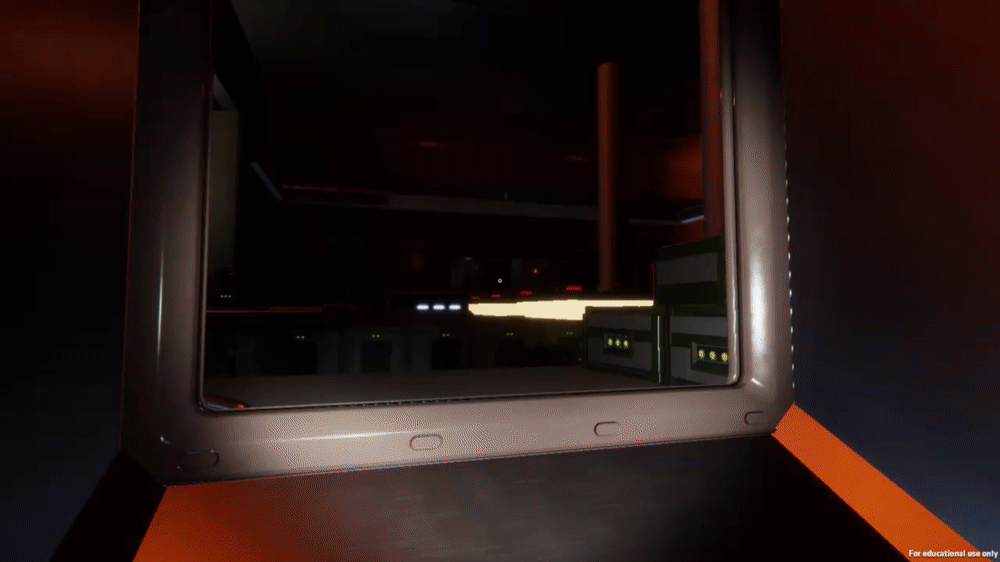
FUTUREGAMES // 2020
SAFETY PROTOCOL
Team of 10 ( 2 designers ) • 7 weeks • Unity
SAFETY PROTOCOL is a narrative-driven, environmental puzzle game that lets you explore an eerie space station while chatting with the stations AI. Reactivate the hidden fuse boxes to increase your power supply. Distribute the power to the different areas inside the station to unlock new paths letting you delve deeper into the story.
THINGS THAT I DID



LEVEL DESIGN: I was responsible for all the level design in the game. I worked on everything from 2D-sketching, to grayboxing, to implementing final 3D assets.
NARRATIVE: I co-authored the narrative design and wrote all of the game's dialogue trees and message logs. I also planned the environmental storytelling.
COLLABORATION: Working closely with the other team disciplines in creating the UX, UI, power management mechanic, and overall game feel and mood.
DESIGN PILLARS



EXPLORATION AND LIGHT PLATFORMING:
The player explores the station and traverses it in interesting ways while interacting with objects that unlock new paths and tell the story.
SUSPICION: The narrative is what drives the player forward. As you delve deeper into the space station you gradually begin to distrust the station's AI and its maker.
FIND POWER AND BUILD YOUR PATH:
The station's available power is a precious resource to the player which they must allocate carefully in order to open locked doors or power up rooms.
GAME LOOP
Find fuse boxes to increase the station's power. Interact with consoles to distribute the power to rooms and hallways.
Gradually unlock the broken space station and find out what happened to the missing crew.
REACH A CONSOLE

FIND THE NEXT FUSE BOX
Increase power supply
ENVIRONMENT
PUZZLES
CONSOLE UI //
CHAT TAB
New dialogue options
CONSOLE UI //
POWER SUPPLY TAB
Distribute power to rooms and doors
LEVEL DESIGN PROCESS
Exploration and building your own path with the power management mechanic were parts of our core design pillars. Therefore, we designed the space station in a non-linear way that gave the player freedom to explore.
PLAN
Mind-mapping how the player could move about and manage the power supply.
2D LAYOUT
Drawing in Miro meant that the map was accessible to all team members as we were working from home.
GRAYBOX
Making a very rough version of the space station, playtesting it, and iterating, using ProBuilder.
GRID
We opted for a grid-based level. This made iterating fast and easy since we could use snapping.
ITERATE
Implementing 3D assets, playtesting, and tweaking. Rinse and repeat.
ITERATIONS
Initially, we had the first console interaction take place in a separate, smaller room.
That didn't give it the prominence needed, so we opted for the corridor-like HUB layout instead.
"It's your first day onboard the
VASA Space Station. But the ship has broken down and the crew is missing."
SUSPICION IN STORYTELLING
Suspicion was one of our core design pillars. We aimed to make the player feel a growing distrust throughout the game and present the story in puzzle pieces that the player needs to put together in order to uncover the truth.
INTRO
I focused on establishing a connection between the player and the missing crew. We track in on their portrait while seeing a formal welcome message from the commander. The tone of the message contrasts with the unsettling glitches and eerie music.
The rumbling at the end lets the player know that something terrible has happened, but we don't know what just yet.
Video editing by Erika Hennel

TED ENGQVIST, COMMANDER
Reliable man in charge. Dead.
HANK BONNER, LAB TECH
Young and likes to gossip. Has a love affair with Chiara. Dead.
Concept art by Erika Hennel
CHIARA GUZMAN, CARGO OPS
Trusty co-worker onboard despite her alcoholic tendencies. Dead.
ALFRED SCHMIDT, SCIENTIST
The creator of the station's AI; Alice, and antagonist of the game. Still alive.
VASA CREW
ENVIRONMENTAL STORYTELLING
Early on, the player learns that the station has broken down because of a disastrous airlock breach that nearly flushed out every crew member on board. That's why the player is met by tossed around containers and deformed catwalks.
DIALOGUE OPTIONS
We wanted Alfred to come across as a suspicious character. Not only in the way he's written, but also by providing interesting dialogue options for the player. You can choose to either comply with him or question him.
Cutting the text into short chat messages made the reading feel engaging and snappy.
TWO SIDES OF THE STORY
The information the player receives through the console contradicts information found elsewhere in the game. The more you inspect your surroundings, the more suspecting you become.
CONSOLE INTERACTIONS
When interacting with the console the player only receives information from Alfred and the AI.
Example: Alfred blames Chiara for having caused the airlock breach that killed the crew.
.png)
.png)
Concept art by Axel Nilsson
MESSAGE TERMINALS
Message terminals are scattered around the space station. They contain logs that were sent before the accident happened. The information the player gets through the terminals contradicts the information received from the consoles.
Example: Chiara informs Ted that Alfred has access to the airlock.


NARRATIVE PROPS
When interacting with the terminals the camera zooms in on the message. But you're still able to see parts of the background. We used this space to place props that served the story.
Example: The player enters Alfred's office and sees the airlock codes on his desk. Without any doubt, he's our culprit.
.png)
1
2
3
DIALOGUE TREE
Zoom and drag.










































.png)
